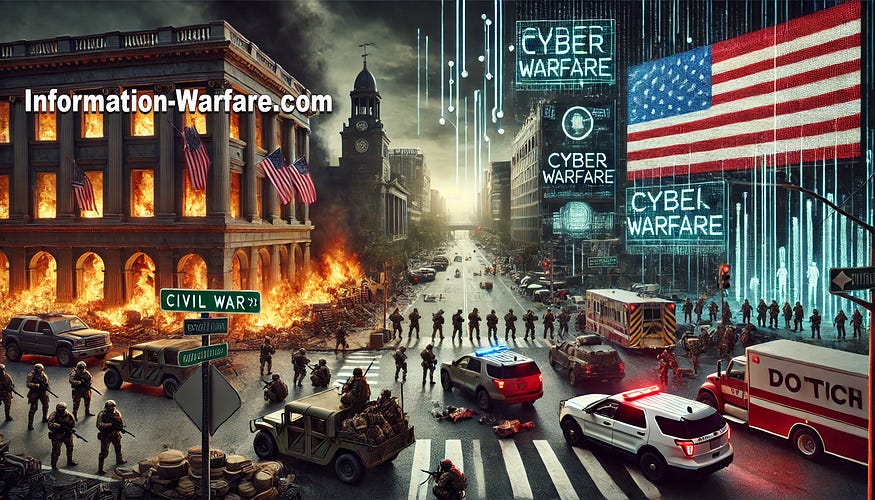What Would a Second US Civil War Really Look Like?
A second US Civil War is a concept that has been explored in various analyses and speculative scenarios.

While it remains a hypothetical situation, understanding the potential dynamics, causes, and impacts can provide insights into the societal and political tensions within the United States. Here is a detailed exploration of what a second US Civil War might look like:
Potential Causes
1. Political Polarization:
— Extreme Partisanship: The deepening divide between political parties, particularly between the far-right and far-left, could escalate tensions to the point of armed conflict.
— Disputed Elections: Contested election results, accusations of voter fraud, and refusal to accept outcomes could trigger violent responses.
2. Economic Inequality:
— Economic Disparities: Widening income gaps and perceived economic injustices could lead to widespread unrest and support for radical change.
— Resource Competition: Scarcity of resources such as water, food, and energy could exacerbate tensions, particularly in regions hit hard by climate change.
3. Racial and Social Injustice:
— Systemic Racism: Continued racial discrimination and police violence against minority communities could ignite civil unrest.
— Social Inequities: Disparities in access to healthcare, education, and housing could lead to large-scale protests and conflicts.
4. Cultural and Ideological Conflicts:
— Cultural Wars: Disputes over issues like gun control, abortion, LGBTQ+ rights, and immigration could polarize communities.
— Identity Politics: Clashes over national identity, patriotism, and historical narratives could fuel division.
Characteristics of a Modern Civil War
1. Asymmetric Warfare:
— Guerrilla Tactics: Unlike the organized armies of the 19th century, a modern civil war would likely involve guerrilla tactics, urban warfare, and small, decentralized militias.
— Cyber Warfare: Digital attacks on infrastructure, misinformation campaigns, and hacking would play a significant role in destabilizing regions.
2. Regional Secessions:
— Breakaway States: Some states or regions might attempt to secede from the Union, leading to localized conflicts and the formation of autonomous zones.
— Urban vs. Rural Divide: Major cities might become strongholds for certain factions, while rural areas support opposing groups.
3. Foreign Intervention:
— Global Impact: Other nations might intervene either overtly or covertly, supporting various factions to further their geopolitical interests.
— Refugee Crisis: Large-scale displacement of people seeking safety could lead to a refugee crisis both within the US and in neighboring countries.
4. Economic Disruption:
— Supply Chain Breakdown: Disruptions in transportation, production, and trade could lead to shortages of essential goods and economic collapse.
— Infrastructure Damage: Widespread damage to infrastructure, including power grids, water supplies, and communication networks, would exacerbate the crisis.
Humanitarian Consequences
1. Casualties and Displacement:
— High Death Toll: Civilian and combatant casualties could be significant, leading to a humanitarian crisis.
— Mass Displacement: Millions could be displaced, leading to overcrowded refugee camps and strain on resources.
2. Human Rights Violations:
— Atrocities and War Crimes: Both sides could commit human rights violations, including massacres, torture, and ethnic cleansing.
— Suppression of Freedoms: Martial law, curfews, and suppression of free speech and assembly could become commonplace.
3. Psychological Impact:
— Trauma and PTSD: The psychological toll on survivors, including trauma and PTSD, would be immense.
— Societal Fragmentation: Long-term societal divisions and mistrust would make post-war reconciliation challenging.
Scenarios and Outcomes
1. Prolonged Conflict:
— Stalemate: A prolonged conflict could result in a stalemate, with neither side able to secure a decisive victory, leading to a drawn-out war of attrition.
— Fragmentation: The US could fragment into multiple regions with different governance systems, potentially leading to ongoing low-intensity conflicts.
2. Authoritarian Takeover:
— Military Coup: A military or authoritarian leader could seize power to restore order, resulting in the suspension of democratic processes and civil liberties.
— Dictatorship: The imposition of a dictatorship could bring temporary stability at the cost of freedom and human rights.
3. Peaceful Resolution:
— Negotiated Settlement: Diplomatic efforts and negotiations could lead to a ceasefire and a political settlement that addresses some of the underlying grievances.
— Reconstruction and Reconciliation: Post-war efforts would focus on reconstruction, reconciliation, and rebuilding democratic institutions.
Preventive Measures
1. Strengthening Democracy:
— Electoral Reforms: Ensuring fair and transparent elections can reduce the risk of disputed outcomes and political violence.
— Civic Education: Promoting civic education and engagement can strengthen democratic norms and reduce polarization.
2. Economic and Social Policies:
— Addressing Inequality: Implementing policies that reduce economic disparities and provide social safety nets can mitigate some of the root causes of conflict.
— Promoting Inclusion: Efforts to promote racial and social inclusion can help reduce tensions and foster unity.
3. Conflict Resolution:
— Mediation and Dialogue: Establishing platforms for dialogue and mediation between opposing groups can prevent conflicts from escalating.
— Community Building: Investing in community-building initiatives can strengthen social cohesion and resilience.
Conclusion
While a second US Civil War remains a hypothetical scenario, the factors that could lead to such a conflict are real and present in contemporary society. Addressing these underlying issues through democratic reforms, economic and social policies, and conflict resolution initiatives is crucial for maintaining peace and stability. Understanding the potential dynamics and consequences of a civil war can help policymakers, scholars, and citizens work towards a more unified and resilient nation.

